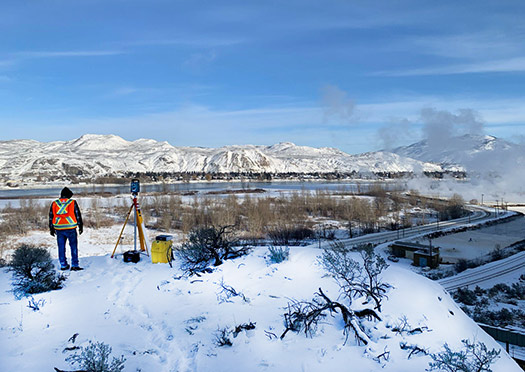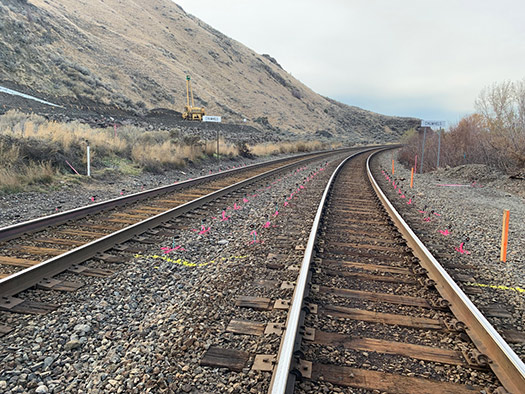December 2023, Vol. 250, No. 12
Tech Notes
Real-Time Monitoring Helps Trans Mountain Expansion Stay on Track
By Rowland Chen, Monitoring Division, Trimble
(P&GJ) — When it comes to installing hundreds of kilometers of pipeline across widely varying terrain, every road, river and rail has the potential to cause delay or even a complete shutdown.
Such was the case for the $31 billion Trans Mountain Expansion Project (TMEP) — a massive multi-year effort to install a new, much larger oil pipeline alongside the existing system, which stretches from Strathcona County (near Edmonton), Alberta, to Burnaby, British Columbia.
RELATED: Trans Mountain Pipeline Expansion Nears 95% Completion, Set to Triple Crude Oil Capacity
Though complex, the outwardly straightforward effort was nearly derailed during the drilling of a single underground crossing, set beneath an active rail line.
Vertical Limits
The TMEP includes the installation of 36-inch and 42-inch pipes — as well as new pump stations and storage tanks — along the existing route. Contractors were on track to bore a tunnel that would allow the new pipeline to be installed underneath one of Canada’s most active railways.
Canadian Pacific Railway runs about 75 trains (both passenger and freight) per day on this line, while the Canadian National Railway Company adds a few more to the daily tally.
Canadian Pacific specified that TMEP must monitor rail movement 24/7 during the installation of the pipeline — particularly during the boring process — and all observations needed to be done without getting anywhere near the tracks.
TMEP looked to its surveyor, GeoVerra, to provide services to TMEP that range from establishing a project-wide control network along the pipeline to field survey and plan preparations for watercourse, road, highway and utility crossings, for detailed engineering and third-party permitting purposes. The firm has further applied advanced technology — such as mobile mapping, unmanned aerial vehicles (UAVs) and micro-drones — to support construction.
“Our primary role was to provide horizontal and vertical positioning of the pipeline along the route. We record every single piece of pipe length, its number and location as it’s placed in the ground," said Michael Nixon, GeoVerra’s field supervisor. “We were also providing construction support to the general contractor, which might involve taking boundaries, tying in creek crossings and profiles for engineers.”
The construction support helped keep the tunnel boring under the rail line moving forward safely and efficiently. The rail owner’s biggest concern was the vertical ground movement. Any void space created by boring this tunnel could compress the ground, which would directly affect the rail alignment on the surface.
Nixon said he was approached by the TMEP engineer, who asked us to find a way to monitor track movement.
“It was imperative we come up with a solution because there was no other route option for the pipeline,” he said. “Other than having a surveyor on site 24/7, automated monitoring total stations seemed the best and only way to gather data with the required frequency.”
Nixon selected the Trimble S7 robotic total station, with a radio included, and a Trimble S8 robotic total station, for its flexibility of use for imaging, basic scanning and survey activities.
In this case, the engineering team was only looking for vertical deformation of the ground around the tracks, and the specifications were tight. If that deformation exceeded one centimeter, it would have triggered the need to adjust the bore drilling. If it exceeded two centimeters, then crews had to stop all work. And if it exceeded 3 centimeters, the trains had to be shut down.
A Spot Shot
The team set up one fully automated monitoring total station (AMTS) on each side of the tracks (one on the north side and one on the south side), to fully cover the construction zone and ensure visibility to the prisms, in case a train was passing or parked on the tracks.
This total station offers 1-second angular accuracy and electronic distance measurement (EDM) precision of 1 mm + 1 ppm, plus servo-technology able to detect movements faster and initiate alarms earlier.
“One of the Canadian Pacific requirements was that we couldn’t set up within the rail right-of-way. The hill was the only spot where it wouldn’t be disturbed by construction or trains,” Nixon said. “With the setup of the total stations and T4D so straightforward and intuitive, it was easy to set up wherever needed.”
The GeoVerra team then set control points, and they placed two rows of monitoring prisms between the tracks. The prisms, about 150 in total, were set along the rail tracks (Figure 1, rectangular area), that stretched 30 meters each way from the center line (60 meters total).
With the Settop M1 communicating data, the T4D monitoring software gathered measurements — while managing and analyzing data and alerts. Each total station required 15-20 minutes to collect and share the data gathered from the prisms, and both operated 24/7 for the duration of the construction.
Exceeding Expectations
The good news for both the rail authorities and TMEP was that any vertical displacements were well within the plus or minus two millimeters the engineers specified for continuous operation.
Nixon said, “Deformation was minimal, even when there were four or five trains a day passing along the tracks. The S7 and the S8 performed flawlessly and with impressive results. Initially, I was worried the S8 may not have the same precision at the 330-foot (100-meter) distance, but it worked exceptionally well.”
“I would review the data and prepare a report that I sent to TMEP and its engineering partner once a day, largely because they were confident that, if there were an exceedance, an alert would be sent instantly to all key people,” he continued.
The monitoring of the project was maintained for about a month.
Nixon added, “I thought the total stations were going to require much more maintenance, but it was very little. We had to swap out and recharge the total station batteries every three days; that was it.”
The TMEP is on track for mechanical completion by the end of 2023, and the pipeline is anticipated to be in-service by the first quarter of 2024. Once completed, the pipeline system will have nearly tripled its capacity, representing an increase of 590,000 bpd to a total of 890,000 bpd.
The expanded pipeline will be a key piece of Canada’s energy infrastructure that provides a much-needed route to the west coast, for direct access to international markets, including the United States and Asia.
Author: Rowland Chen is a monitoring sales manager at Trimble. He has been at Trimble for six years, supporting and installing automated monitoring systems around the world. Rowland received a bachelor’s degree in geophysics, from the Colorado School of Mines, and he is based in Denver, Colorado.








Comments